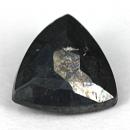|
ClassicGems.net |
|
|
 |
| Acanthite |
|
|
Discovered in 1783; IMA status: Valid (pre-IMA; Grandfathered) | |||
|
|
|
Chemistry |
|
|
| |
|
Ag2S | |
|
|
Silver Sulfide |
|
Molecular Weight: |
247.80 gm |
|
Composition: |
Silver |
87.06 % |
Ag |
|
|
|
|
Sulfur |
12.94 % |
S |
|
|
|
|
|
100.00 % |
|
|
|
|
|
|
||||
|
Classification |
|
|
| |
|
Sulfides and Sulfosalts | |
|
2/B.05-10 | |
|
|
2 : SULFIDES and SULFOSALTS (sulfides, selenides,
tellurides; arsenides, antimonides, bismuthides; sulfarsenites,
sulfantimonites, sulfbismuthites, etc.) |
|
Related to: |
Acanthite Group. Isostructural with Aguilarite. Acanthite is the low-temperature version of Argentite. |
|
Members of Group: |
Acanthite Group: Acanthite, Aguilarite, Cervelleite |
|
Varieties: |
Zincian Acanthite |
|
Synonyms: |
Acantite, Akanthite, α-Argentite, Argentite, Argentite-beta, Argentite-β, Argyrite, Argyrose, Beta-Argentite, β-Argentite, Daleminzite, Henkelite, ICSD 30445, Para-Silberglanz, PDF 14-72, Silver Glance, Vitreous Silver |
|
|
|
|
Crystal Data |
|
|
|
|
|
Primary crystals are rare, prismatic to long prismatic, elongated along [001], to 2.5 cm, may be tubular; massive. Commonly paramorphic after the cubic high-temperature phase (“argentite”), of original cubic or octahedral habit, to 8 cm. |
|
|
Polysynthetic on {111}, may be very complex due to inversion; contact on {101} |
|
|
|
|
|
Physical Properties |
|
|
|
|
|
Indistinct, none observed |
|
|
Irregular/uneven, sub-conchoidal |
|
|
Sectile |
|
|
2.0 - 2.5; Vickers: VHN100=21 - 25 kg/mm2 |
|
|
7.2 - 7.4 (g/cm3) |
|
|
None |
|
|
Not Radioactive |
|
|
|
|
|
Optical Properties |
|
|
|
|
|
Lead grey, iron black |
|
|
Opaque |
|
|
Metallic |
|
|
R: (400) 32.8, (420) 32.9, (440) 33.0, (460) 33.1, (480) 33.0, (500) 32.7, (520) 32.0, (540) 31.2, (560) 30.5, (580) 29.9, (600) 29.2, (620) 28.7, (640) 28.2, (660) 27.6, (680) 27.0, (700) 26.4 |
|
|
n/a (opaque) |
|
|
n/a |
|
|
n/a |
|
|
Weak |
|
|
|
|
|
Occurances |
|
|
|
|
|
Geological Setting: |
A common silver species in moderately low-temperature hydrothermal sulfide veins, and in zones of secondary enrichment. |
|
Common Associations: |
Silver, Pyrargyrite, Proustite, Polybasite, Stephanite, Aguilarite, Galena, Chalcopyrite, Sphalerite, Calcite, Quartz |
|
Common Impurities: |
Se |
|
Type Locality: |
Jáchymov (St Joachimsthal), Jáchymov District (St Joachimsthal), Krušné Hory Mts (Erzgebirge), Karlovy Vary Region, Bohemia (Böhmen; Boehmen), Czech Republic |
|
Year Discovered: |
1855 |
|
View mineral photos: | |
|
|
|
|
More Information |
|
|
|
|
|
| |
|
|
|
|
Acanthite is a silver sulfide mineral and is one of the most important ores of Silver. Acanthite was named in 1855 by Gustav Adolf Kenngott from the Greek word akantha meaning thorn, in allusion to its crystal shape. The name Acanthite is often confused with, or used interchangably with, Argentite. Acanthite and Agrentite have the same chemistry, Ag2S, but different structures. Acanthite is the low-temperature form of Argentite. Acanthite has a monoclinic structure and is stable below 173 degrees Celsius while Argentite has an isometric structure and is only stable at temperatures above 173 degrees Celsius. All natural silver sulphide specimens (and gems) at room temperature are Acanthite. The tarnish on sterling silver is chemically the same as Acanthite. Acanthite was named in 1855 by German mineralogist Gustav Adolf Kenngott (1818-1897) from the Greek word άκανθα (ákantha) meaning thorn, in allusion to its crystal shape. It was discovered in the Jáchymov District, Krušné Hory Mts, Karlovy Vary Region, Bohemia, Czech Republic. Acanthite distribution: widespread in silver deposits. Localities for fine primary and paramorphic crystals include: from Jáchymov (Joachimsthal), Czech Republic [TL]. In Germany, at Freiberg, Schneeberg, Annaberg, and Marienberg, Saxony; and from St. Andreasberg, Harz Mountains. In Mexico, large paramorphs from Arizpe, Sonora; in the Rayas and other mines at Guanajuato; and from many mines in Zacatecas, Chihuahua, etc. In the USA, at Butte, Silver Bow County, Montana; Tonopah, Nye County, and the Comstock Lode, Virginia City, Storey County, Nevada. From various mines at Cobalt, Ontario, Canada. At Chañarcillo, south of Copiapó, Atacama, Chile. |
|
|
Acanthite gems for sale: We have not photographed our Acanthite gems yet. Please check back soon. |